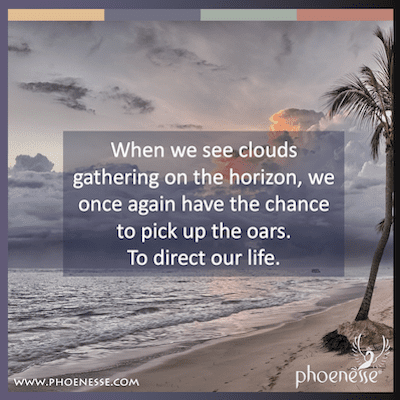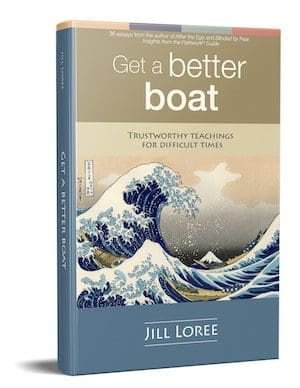
When we see clouds gathering on the horizon, we once again have the chance to pick up the oars. To direct our life.
If we were standing in the Spirit World looking at Earth, we would see this ocean of humanity. For all of us are living in a sea of life. And each life is a little boat. In this picture of things, the sea of life may be stormy and the sky might be grey. But then out comes the sun again, calming the choppy waters. Until another storm comes along.
Isn’t that just the way of life, always alternating between storms and sunny skies? Until one day, we reach our destination.
And what is our destination? Firm land. It sounds backwards, but that’s what God’s Spirit World actually is. The firm ground of the divine is our true home. And getting there all depends on how we direct our little boat. How good are we at navigating life?
How well do we handle storms?
Let’s say we’re someone who feels well-prepared for life. We’ve been well-trained and we’ve got some experience. So we’re a skillful captain who is not afraid of danger. As such, we will steer our little boat well through howling winds and high seas.
Then, when the gentle periods of calm return, we relax and gather our strength for the next storm. For we know there will be rough weather again. And we’ll be ready for it.
Another person gets nervous every time another storm starts brewing. If that’s us, we keep losing control of our life. Yet another person gets so scared they don’t even try to steer their boat. They just drift through the storms of life, hoping for the best and not learning anything.
We need to realize that these difficult conditions in life—these sudden storms—are tests. When we see clouds gathering on the horizon, ushering in another disturbance, we once again have the chance to pick up the oars. To direct our life.
Perhaps if we look around—look at our life—we can sense where our boat is now.
The symbol of the sea
The sea is a symbol telling us loudly and clearly that nothing is ever lost. We can see this in the way the tide ebbs and flows. It flows forward in great waves, only to recede. Where does it go when it seems to disappear and no longer exist?
From where we’re standing on the shore, there was water a moment ago and now it’s gone. But we know the water does not disintegrate into nothing. It continues to exist in the bigger pool of water, without ever losing its unique quality. And it will return.
Maybe it’s the same with us.
Why go through all this effort to cleanse and develop ourselves—to grow and expand—if there isn’t any purpose? Well, in fact, the more connections we discover between our inner attitudes and our experiences in life, the more we will understand that nothing is arbitrary. Every experience has meaning. There are no coincidences.
Our life is a direct reflection of who we are now, on the inside. How we express ourselves determines what we create. And this is true whether we are creating deliberately or unconsciously. Once we start unraveling the tangled threads—gaining awareness of these connections—life will make sense in a whole new way.
We’ll then see that nothing is for naught. There’s a magnificent design at work, trying to bring everything into harmony. Once we discover how the storms in our life connect to the storms in our soul, we will understand the construction of the fabric and see the wisdom woven into it. Seeing how we’ve had a hand in making this fabric will bring us peace.
Rhythms of the sea
The sea ebbs and flows, following a very particular rhythm. Its rhythm may be temporarily disrupted—by earthquakes or tidal waves or human interference—but it is never broken. Following a crisis, the sea will work to reestablish its unique rhythm so that once again, it is in harmony with the rest of creation.
The sea is wise in the way it follows this pattern. Humans, on the other hand, with our busy and distracted minds, often tune out our unique rhythm patterns.
If we look at the time span between the ebb and flow of the sea—between high tide and low tide—it’s never exactly the same. One will last longer than the other. It’s the same with our human rhythms. Sometimes things come to fruition more quickly. In other areas, the waiting may last longer.
When we are out of rhythm with ourselves, it can help to pray to see connections between events and our inner selves. But maybe the answers don’t come right away. Then we could use this waiting time to learn more about ourselves. To learn things that only show up in times of ebb, not in times of flow.
Sensing our rhythm in all things
Our job is to learn to sense our own rhythm in all things. If we learn to rest and to play—to work and move in harmony with our own unique rhythm—we will live a more fruitful life. We will be more creative, more joyful, and more peaceful. Restlessness will fall away and we won’t feel so burdened by life.
To reach this way of living, we must raise the level of our consciousness. Just sitting with the reality that this possibility exists can help us get there. We can stir our imagination and feel into what it would be like to live a day in rhythm. Imagine smooth sailing. Then compare that with the way life usually feels. The way it feels to unconsciously follow a rhythmless existence.
By visualizing the difference daily, we can start to tune into our little boat and see how we are doing. We can ask for personal guidance that flows from within, to help us stay focused on this. And to stay, more and more, in our own rhythm pattern.
Losing our rhythm
We all have days when we feel out of sorts. This happens when there is something tangled up in our consciousness that we aren’t yet aware of. And it makes us feel disconnected from whatever we are experiencing. If we can accept this rhythm pattern, respecting it and using it in a constructive way, then our rhythm will take its natural course and return to flowing once again without disturbance. Just like the sea.
But instead, we tend to respond destructively, delaying the return of our rhythm pattern to its natural flow. We do this by doubting and rebelling, by deciding this is a meaningless universe after all. Or maybe we get angry because we are suffering. Equally disruptive is having a self-rejecting attitude that says, “I am such a bad person. I deserve to be punished like this.”
According to the Pathwork Guide, nothing is more painful and more frightening than not seeing the connection between a painful event in our lives and its inner cause. To have storms arise for seemingly no reason, and to feel we have no say. Once we start establishing the inner causes, however, what we will feel is relief.
Get a better boat
So a better response to difficulties in life would be: What can I learn from this? What can I learn while the tide stays out that I couldn’t learn after it flows in? What inside me do I not yet see? Have I lost sight of the fact that I am a unique expression of God? Am I aware that God always loves me?
These are positive ways to respond that will help our rhythm return to a more harmonious course. Then, taking their own time—and probably when we least expect it to happen—connections will start to open up. Suddenly, truthful understandings may pour forth in an abundant river of awareness. Our woe will disappear, and our suffering will transform into the rich blessing it always had the potential to be.
And the one who is always standing ready to help us make these connections? None other than Christ. We can actively help ourselves find harmony in our lives by making personal contact with Christ. But rhythm patterns are at work here as well.
In our minds, we might be completely comfortable with the reality of Jesus Christ. In our will, we may be willing to surrender to Christ, and we might really mean it. But we may not yet have felt, in our emotions, the sweet and loving presence of Christ in our life.
Perhaps we’re still waiting for this happen. So then we may become impatient that it ever will. We’ll start to doubt. And that’s how we disrupt the seeds we have sown.
When we wait, but the emotional experience fails to arrive, it’s not that Christ is keeping us waiting. It’s that we still have inner barriers that need to give way. And this will happen once we restore our unique personal rhythm.
“Please, my friends, remember these words well, because here your personal contact with Jesus Christ is again your best solution. Only through allowing yourself to know—and later to feel—His love and total acceptance of who you are now, no matter how flawed, imperfect and destructive your lower self may be, will you be able to do the same. Only then will you trust your ultimate divine nature.
“Then you will be able to afford the luxury, if I may put it this way, of accepting your distortions—your sins, if you will—without losing the ground under your feet. And that is the healthy position which allows you to reach truth and harmony with yourself, with others and with life.”
– Pathwork® Guide Lecture #258: Personal Contact With Jesus Christ—Positive Aggression—The Real Meaning of Salvation
When we are ready to do deeper spiritual work, then we are ready to get a better boat. And in this new boat, we can feel held and guided by Christ, and able to rest. This will give us the sustenance we need to fulfill our task in life.
Even if our senses can’t yet perceive it, Christ cares about each of us. It will help for us to remember this, and not turn to despair. Christ is here, helping us learn to navigate life well, and to guide our little boat to our true destination.
–The Pathwork Guide’s wisdom in Jill Loree’s words

Adapted from Pathwork Guide Lecture #258: Personal Contact With Jesus Christ—Positive Aggression—The Real Meaning of Salvation
We can heal | AFTER THE EGO • BLINDED BY FEAR
The Real. Clear. series | HOLY MOLY • FINDING GOLD • BIBLE ME THIS • THE PULL • PEARLS • GEMS • BONES • NUTSHELLS
The Self. Care. series | SPILLING THE SCRIPT • HEALING THE HURT • DOING THE WORK
More spiritual books | WALKER (a memoir) • SPIRITUAL LAWS • WORD FOR WORD • KEYS (Pathwork Q&As)


